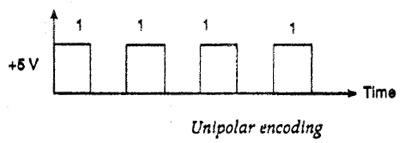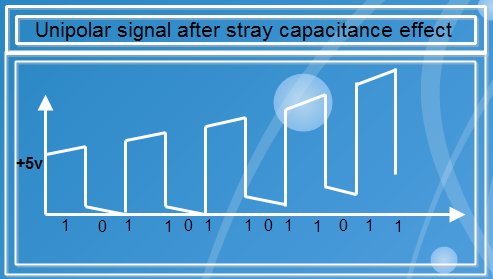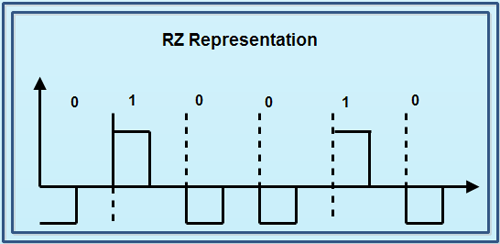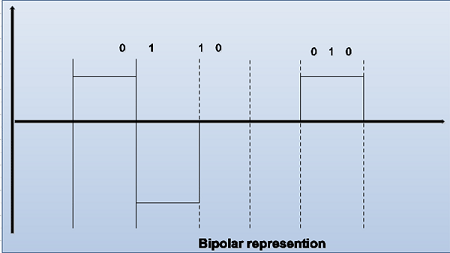It is required that information must be encoded into signals before it can be transported across communication media. In more precise words we may say that the waveform pattern of voltage or current used to represent the 1s and 0s of a digital signal on a transmission link is called digital to digital line encoding. There are different encoding schemes available:
We’ll be covering the following topics in this tutorial:
Digltal-to-Digltal Encoding
It is the representation of digital information by a digital signal.
 There are basically following types of digital· to-digital encoding available like:
There are basically following types of digital· to-digital encoding available like:
- Unipolar
- Polar
- Bipolar.
Unipolar
Unipolar encoding uses only one level of value 1 as a positive value and 0 remains Idle. Since unipolar line encoding has one of its states at 0 Volts, it’s also called Return to Zero (RTZ) as shown in Figure. A common example of unipolar line encoding is the 11’L logic levels used in computers and digital logic.
 Unipolar encoding represents DC (Direct Current) component and therefore, ca.’1nottravel through media such as microwaves or transformers. It has low noise margin and needs extra hardware for synchronization purposes. It is well suited where the signal path is short. For long distances, it produces stray capacitance in the transmission medium and therefore, it never returns to zero as shown in Figure.
Unipolar encoding represents DC (Direct Current) component and therefore, ca.’1nottravel through media such as microwaves or transformers. It has low noise margin and needs extra hardware for synchronization purposes. It is well suited where the signal path is short. For long distances, it produces stray capacitance in the transmission medium and therefore, it never returns to zero as shown in Figure.

Polar
Polar encoding uses two levels of voltages say positive and negative. For example, the RS:232D interface uses Polar line encoding. The signal does not return to zero; it is either a positive voltage or a negative voltage. Polar encoding may be classified as non·return to zero (NRZ), return to zero (RZ) and biphase. NRZ may be further divided into NRZ·L and NRZ·I. Biphase has also two different categories as Manchester and Differential Manchester encoding. Polar line encoding is the simplest pattern that eliminates most of the residua! DC problem. Figure shows the Polar line encoding. It has the same problem of synchronization as that of unipolar encoding. The added benefit of polar encoding is that it reduces the power required to transmit the signal by one-half.

Non-Return to Zero (NRZ)
In NRZ·L, the level of the signal is 1 if the amplitude is positive and 0 in case of negative amplitude.
In NRZ·I, whenever a positive amplitude or bit I appears in the signal, the signal gets inverted,
Figure explains the concepts of NRZ-L and NRZ·I more precisely.

Return to Zero (RZ)
RZ uses three values to represent the signal. These are positive, negative, and zero. Bit 1is represented when signal changes from positive to zero. Bit 0 is represented when signal changes from negative to zero. Figure explains the RZ concept.
 Biphase
Biphase
Biphase is implemented in two different ways as Manchester and Differential Manchester encoding.
In Manchester encoding, transition happens at the middle of each bit period. A low to high transition represents a 1 and a high to low transition represents a 0.In case of Differential Manchester encoding, transition occurs at the beginning of a bit time, which represents a zero.
These encoding can detect errors during transmission because of the transition during every bit period. Therefore, the absence of a transition would indicate an error condition. They have no DC component and there is always a transition available for synchronizing receives and transmits clocks.
Bipolar
Bipolar uses three voltage levels. These are positive, negative, and zero. Bit 0 occurs at zero level of amplitude. Bit 1 occurs alternatively when the voltage level is either positive or negative and therefore, also called as Alternate Mark Inversion (AMI). There is no DC component because of the alternate polarity of the pulses for Is. Figure describes bipolar encoding. Analog to Digital
Analog to Digital
Analog to digital encoding is the representation of analog information by a digital signal. These include PAM (Pulse Amplitude Modulation), and PCM (Pulse Code Modulation).
Digital to Analog
These include ASK (Amplitude Shift Keying), FSK (Frequency Shift Keying), PSK (Phase Shift Keying), QPSK (Quadrature Phase Shift Keying), are QAM (Quadrature Amplitude Modulation).
Analog to Analog
These are Amplitude modulation, Frequency modulation and Phase modulation techniques,
Codec’s (Coders and Decoders)
Codec stands for coders/decompression in data communication. The reverse conversion of analog to digital is necessary in situations where it is advantageous to send analog information across a digital circuit. Certainly, this is often the case in carrier networks, where huge volumes of analog voice are digitized and sent across high capacity, digital circuits. The device that accomplishes the analog to digital conversion is known as a codec. Codec’s code an analog input into a digital format on the transmitting side of the connection, reversing the process, or decoding the information on the receiving side, in order to reconstitute the analog signal. Codec’s are widely used to convert analog voice and video to digital format, and to reverse the process on the receiving end.
 Dinesh Thakur holds an B.C.A, MCDBA, MCSD certifications. Dinesh authors the hugely popular
Dinesh Thakur holds an B.C.A, MCDBA, MCSD certifications. Dinesh authors the hugely popular